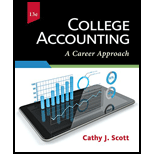
Concept explainers
Use the information presented in Problem C-1 to solve this problem.
Required
Find the cost of the ending inventory by the last-in, first-out method.
PROBLEM C-1 Bean Nursery sells bark to its customers at retail. Bean buys bark from a plywood mill in bulk and transports the bark in its own trucks. Information relating to the beginning inventory and purchases of bark is as follows:

Required
Find the cost of 1,200 cubic yards in the ending inventory by the weighted-average-cost method. Carry average cost per cubic yard to four decimals.
Check Figure
Cost of ending inventory, $480
Want to see the full answer?
Check out a sample textbook solution
Chapter C Solutions
College Accounting (Book Only): A Career Approach
Additional Business Textbook Solutions
Essentials of MIS (13th Edition)
Gitman: Principl Manageri Finance_15 (15th Edition) (What's New in Finance)
PRIN.OF CORPORATE FINANCE
Principles of Microeconomics (MindTap Course List)
FUNDAMENTALS OF CORPORATE FINANCE
Marketing: An Introduction (13th Edition)
 College Accounting (Book Only): A Career ApproachAccountingISBN:9781337280570Author:Scott, Cathy J.Publisher:South-Western College Pub
College Accounting (Book Only): A Career ApproachAccountingISBN:9781337280570Author:Scott, Cathy J.Publisher:South-Western College Pub Intermediate Accounting: Reporting And AnalysisAccountingISBN:9781337788281Author:James M. Wahlen, Jefferson P. Jones, Donald PagachPublisher:Cengage Learning
Intermediate Accounting: Reporting And AnalysisAccountingISBN:9781337788281Author:James M. Wahlen, Jefferson P. Jones, Donald PagachPublisher:Cengage Learning- Century 21 Accounting Multicolumn JournalAccountingISBN:9781337679503Author:GilbertsonPublisher:Cengage
 Cornerstones of Financial AccountingAccountingISBN:9781337690881Author:Jay Rich, Jeff JonesPublisher:Cengage Learning
Cornerstones of Financial AccountingAccountingISBN:9781337690881Author:Jay Rich, Jeff JonesPublisher:Cengage Learning




